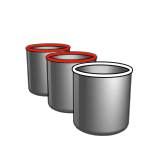Instance Painter
Create copies of objects with a parent-child relationship. When you modify the source objects, all of the instances are updated automatically in the construction history. This is a scene creation tool that is used mainly for rendering.
Edit Instance Options
| Option | Description |
|---|---|
| Density | Change the spacing between each instance. Enter a value from 1 to 10, where 1 spaces the instances the farthest apart and 10 spaces the instances the closest together. |
| Normal to ground | Make the instances normal to the ground (the object under the mouse cursor when you click). |
| Min. distance (%) | Painting instances are time dependent. If you drag the mouse
very slowly, instances are created very close to each other. If
you drag the mouse over the same area repeatedly, new instances
may be created very close to existing ones. By specifying the
minimum distance, you can avoid creating instances that are too
close to each other. Enter a value, specified by the percentage of the instance's width. For example: enter 100 to create instances that are almost touching, 50 to create instances that intersect, or 200 to create instances that are spaced quite a bit apart. |
| Randomness | Randomize the rotation and size of the instances to make each
instance slightly different so your scene looks more realistic.
For example, if you build a forest by painting instances of a
tree, by default all of the trees will be the same size and
oriented in the same direction, which would make the forest look unrealistic.
|
